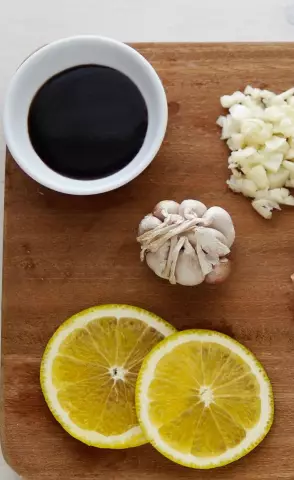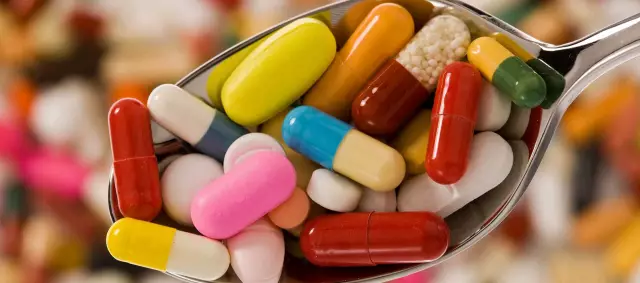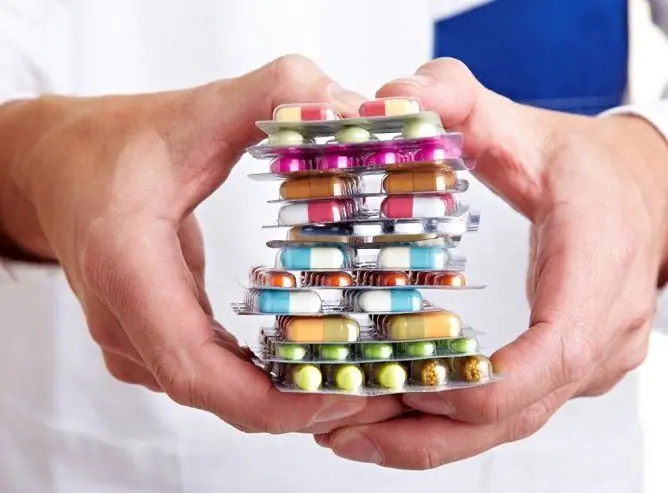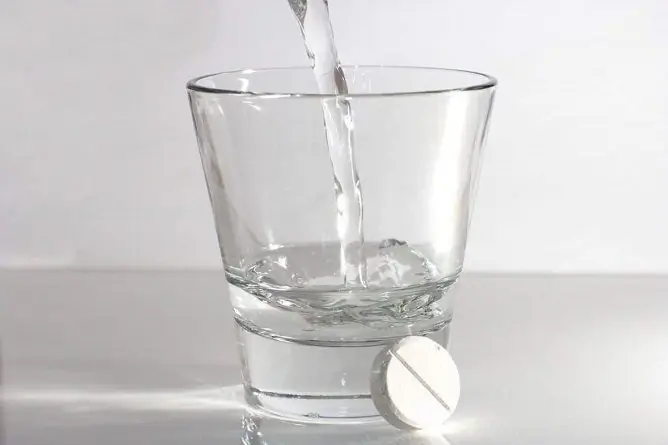- Author Rachel Wainwright [email protected].
- Public 2023-12-15 07:39.
- Last modified 2025-11-02 20:14.
Vasodilator drugs

The activity of the autonomic nervous system affects the muscular wall of each vessel, that is, their tone. The higher the vascular tone, the smaller the lumen of the arteries, veins and capillaries. Narrowing of the diameter of peripheral vessels leads to an increase in the load on the heart, increases systemic blood pressure and somewhat impairs the blood supply to organs and body systems. The nervous system, through its autonomic division, can also increase the vascular tone. The vessels expand under the influence of reflex reactions and some chemicals.
Vasodilators in the body
The vascular wall is able to independently participate in the regulation of the vascular tone. When blood flow is accelerated, for example, due to an increase in systemic blood pressure, the cells of the vascular wall secrete a strong vasodilator factor - nitric oxide. This substance relaxes the muscle layer in the arteries and veins, and, therefore, improves blood circulation, supply of cells with oxygen and nutrients. Such a mechanism for improving the blood supply to peripheral tissues is especially justified during exercise: systemic blood pressure rises, large arteries are in good shape, small vessels are dilated. This means that the muscles quickly and in large quantities receive oxygen and other nutrients. Of course, not only nitric oxide affects the muscle layer of the vascular wall. A number of other compounds have their vasodilating effect. Their effects are especially pronounced in the microvasculature, that is, at the level of the capillaries. These substances include histamine, medulin, prostaglandins, bradykinin, acetylcholine, adenylic, lactic and carbonic acids. Various factors contribute to the release of these vasodilators. Of greatest importance are: temperature factor, physical activity, increased pressure, oxygen starvation of tissues. Both vasoconstriction and their dilation are protective adaptive reactions of the circulatory system. These adaptation mechanisms contribute to the full blood supply of all cells in various conditions of existence. Various factors contribute to the release of these vasodilators. Of greatest importance are: temperature factor, physical activity, increased pressure, oxygen starvation of tissues. Both vasoconstriction and vasodilation are protective adaptive reactions of the circulatory system. These adaptation mechanisms contribute to the full blood supply of all cells in various conditions of existence. Various factors contribute to the release of these vasodilators. Of greatest importance are: temperature factor, physical activity, increased pressure, oxygen starvation of tissues. Both vasoconstriction and their dilation are protective adaptive reactions of the circulatory system. These adaptation mechanisms contribute to the full blood supply of all cells in various conditions of existence.
When the normal vascular tone is disturbed
Usually, no additional medical effects on vascular tone are required. When the situation requires it, the vessels dilate, and when an increased tone is required, the vessels narrow. But, unfortunately, sometimes the processes of maintaining the correct tone of the vascular wall are disrupted, and then vasodilating drugs may be required. What diseases contribute to these disorders? First of all, it is necessary to note hypertension. This pathology is most often accompanied by a high tone both in the central and peripheral vessels. Increased pressure and high resistance in blood vessels contribute to the appearance of complications of hypertension. For example, heart, eyesight, and kidney function are often affected. Another disease is angina pectoris. It can be caused by a spasm of the blood vessels of the heart. These coronary vessels can also be damaged as a result of systemic atherosclerosis. Obesity is another condition that causes high vascular tone. Obesity often causes high blood pressure and requires the use of vasodilators. Even mental disorders affect vascular tone. In particular, depression may be accompanied by excessive muscle tension of the vascular wall. Vascular tone disorders are widespread in metabolic diseases. Diabetes mellitus causes a decrease in the nervous regulation of vascular tone. With long-term disorders of carbohydrate metabolism, the normal reactions of the vessels to cold, heat, oxygen starvation disappear. So, we see that many pathological conditions cause vasospasm. In such conditions, vasodilating medicines or folk remedies are needed.
Vasodilator drugs
Vasodilators are medicines that reduce the tone of the smooth muscles of the blood vessels. The pharmaceutical industry produces various types of vasodilating drugs. Some of them mainly affect the nervous tissue. These are called neurotropic vasodilators. Such pharmacological agents include the well-known validol, reserpine, sympatholytics and many other drugs. There are vasodilating medications that act primarily on the muscle cells of the vascular wall. They are called myotropic drugs. Examples of such medicines are the commonly used papavirin, dibazol, aminophylline. Nitrates have neurotropic and myotropic vasodilating effects. Nitroglycerin, nitrosorbitol and other nitrates also affect the vasomotor center,and on the smooth muscles of the vessels, that is, their effect is mixed.

The role of vasodilator drugs in medicine
Vasodilator drugs are widely used in the treatment of diseases of internal organs. Arterial hypertension is treated with their help and with a crisis, and with a stable course. The specific treatment regimen for a patient with hypertension is selected by a general practitioner or cardiologist. Angina pectoris often requires the appointment of constant use of vasodilators. Validol, nitrites and nitrates (amyl nitrite, nitroglycerin, erinit, nitranol, nitrosorbide), xanthine derivatives (euphyllin, temisal), papaverine, chloracizin exert the greatest influence on the coronary vessels. With violations of the blood supply to the brain, nicotinic acid, papaverine and aminophylline can be prescribed. Raynaud's disease, endoartereitis are treated with neurotropic vasodilator drugs. For example, benzohexonium or pentomine may be prescribed. Its place in ophthalmology, neurology,obstetrics and other areas of medicine are occupied by different groups of vasodilator drugs.
Vasodilator folk remedies
Sometimes vasodilating folk remedies are used to maintain a low vascular tone. They have a supportive role in the treatment of diseases and complement the medical treatment prescribed by the doctor.
Decoctions and tinctures from medicinal plants can be made at home. Vasodilator folk remedies include decoctions of valerian, hawthorn, periwinkle, hazel bark. Garlic oil can also be made at home and used to dilate blood vessels. Collection of vasodilating herbs are sold in pharmacies. There you can also buy ready-made herbal teas for the treatment of increased vascular tone.
Vasodilator folk remedies are also methods of reflex action on the body (cold - swimming in an ice hole, dousing with water; with heat - visiting a sauna, bath). Physical activity helps to normalize vascular tone and reduce pressure within 12 hours after exercise. Also, alcohol in small doses can lower the vascular tone. Vasodilator folk remedies should be used only after consulting your doctor.
YouTube video related to the article:
Found a mistake in the text? Select it and press Ctrl + Enter.






